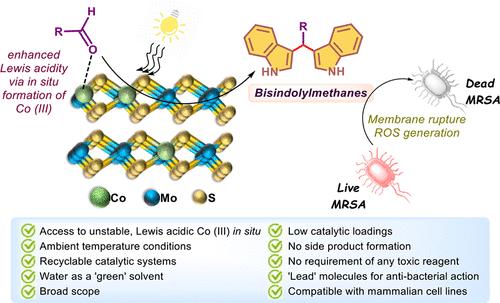Effect of Metal Doping on the Catalytic Activity of MoS2: Access to High-Spin Co (III) Species In Situ toward the Synthesis of Bisindolylmethanes and a Study of Their Bioactivity
IF 8.2
2区 材料科学
Q1 MATERIALS SCIENCE, MULTIDISCIPLINARY
引用次数: 0
Abstract
Nanomaterials such as transition metal dichalcogenides (TMDs) have emerged as sustainable and promising catalytic agents in synthetic chemistry. Doping of the TMDs with a transition metal activates the basal plane/edge. However, such systems have not been explored much for catalytic applications, including the generation of suitable or essential reactive intermediates, to date. Herein, by using a suitable amalgamation of nanomaterial-mediated photocatalysis, we have explored this possibility of accessing the unstable Co (III) species with higher Lewis acidity. Taking the synthesis of bisindolylmethanes as the model reaction, the stable Co (II)-doped MoS2 was used as the catalyst. The enhanced activity of the material in the presence of light was attributed to the in situ conversion of Co (II) to the short-lived and Lewis acidic Co (III) via electron transfer to the Mo center. The performance of the material surpasses that of the commercial Co complexes, validating our hypothesis and providing access to several bisindolylmethane derivatives. In contrast to most of the known Lewis acids, the material could retain its activity in subsequent runs. Further, the as-prepared bisindolylmethanes exhibited bacteriostatic/bactericidal effects against MRSA and were found to be compatible with the mammalian cell environment. Thus, the protocol highlights the potential of heterogeneous nanomaterial-mediated synthetic routes for the fabrication of biologically important molecules in a single step and further expands the utility of photomediated strategies for the in situ access of the otherwise unstable and uncommon Co (III) species, which can be conceptually extended to other transformations as well.

金属掺杂对二硫化钼催化活性的影响:高自旋Co (III)的原位获取及其生物活性研究
过渡金属二硫族化合物(TMDs)等纳米材料已成为合成化学中具有可持续发展前景的催化剂。掺杂过渡金属的tmd激活了基面/边缘。然而,迄今为止,这种系统还没有被广泛用于催化应用,包括生成合适的或必需的反应中间体。在此,通过使用纳米材料介导的光催化的适当合并,我们探索了获得具有较高刘易斯酸度的不稳定Co (III)物质的可能性。以合成双吲哚甲烷为模型反应,采用稳定的Co (II)掺杂MoS2作为催化剂。在光存在下,材料的活性增强是由于Co (II)通过电子转移到Mo中心,在原位转化为寿命短的刘易斯酸性Co (III)。该材料的性能超过了商业Co配合物,验证了我们的假设,并提供了几种双吲哚甲烷衍生物的途径。与大多数已知的刘易斯酸不同的是,这种物质可以在随后的运行中保持其活性。此外,制备的双吲哚甲烷对MRSA具有抑菌/杀菌作用,并且与哺乳动物细胞环境相容。因此,该方案强调了异质纳米材料介导的合成途径的潜力,可以在一个步骤中制造生物学上重要的分子,并进一步扩展了光电介导策略的实用性,用于原位获取其他不稳定和不常见的Co (III)物种,这也可以在概念上扩展到其他转化。
本文章由计算机程序翻译,如有差异,请以英文原文为准。
求助全文
约1分钟内获得全文
求助全文
来源期刊

ACS Applied Materials & Interfaces
工程技术-材料科学:综合
CiteScore
16.00
自引率
6.30%
发文量
4978
审稿时长
1.8 months
期刊介绍:
ACS Applied Materials & Interfaces is a leading interdisciplinary journal that brings together chemists, engineers, physicists, and biologists to explore the development and utilization of newly-discovered materials and interfacial processes for specific applications. Our journal has experienced remarkable growth since its establishment in 2009, both in terms of the number of articles published and the impact of the research showcased. We are proud to foster a truly global community, with the majority of published articles originating from outside the United States, reflecting the rapid growth of applied research worldwide.
 求助内容:
求助内容: 应助结果提醒方式:
应助结果提醒方式:


